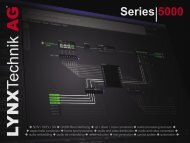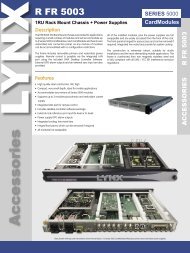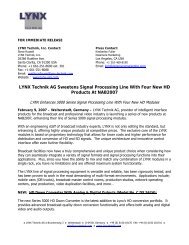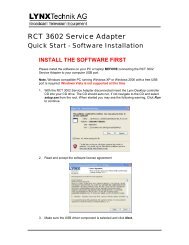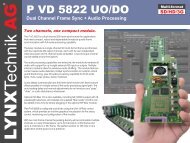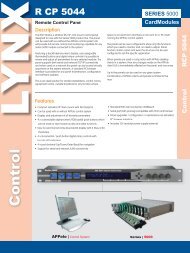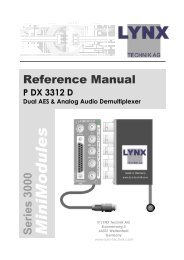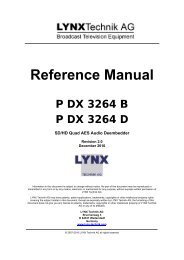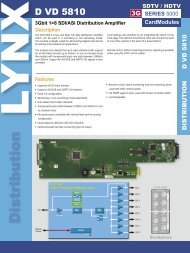Reference Manual - LYNX Technik AG
Reference Manual - LYNX Technik AG
Reference Manual - LYNX Technik AG
You also want an ePaper? Increase the reach of your titles
YUMPU automatically turns print PDFs into web optimized ePapers that Google loves.
Color Space Conversion<br />
Page 22 of 52<br />
P IE 5810 <strong>Reference</strong> <strong>Manual</strong>. Rev 2.6<br />
The conversion options also provide integrated color space conversion capability which<br />
will automatically compensate for the conversion of the wider 709 HD color space into the<br />
more narrow 601 SDTV color space or vice versa ensuring legal color reproduction.<br />
NOTE. Color space conversion can be bypassed or set to only process<br />
chrominance if desired.<br />
Noise Reduction (optional: OC-5810-NR)<br />
The module provides optional Noise Reduction functionality:<br />
The adaptive noise reduction function processes the input data in either progressive or<br />
interlaced format. Application of noise reduction to noisy interlaced signals can optimize<br />
the de-interlacer performance.<br />
General Noise Reduction<br />
General noise reduction comprises of both adaptive 2D and 3D noise reduction. 3D noise<br />
reduction corrects for temporal and spatial noise; and 2D noise reduction corrects spatial.<br />
3D noise reduction is applied to any interlaced or progressive signal with a pixel rate less<br />
than or equal to 75Mp/s. 2D noise reduction is applied to any interlaced or progressive<br />
signal. The selection of 2D or 3D noise reduction processing is automatically controlled<br />
by the firmware in accordance with the video signal being processed.<br />
Block Artifact Reduction<br />
Block Artifact Reduction (BAR) locates and reduces block edges produced by DCT based<br />
compression processing. BAR can be applied to any interlaced or progressive input<br />
signal.<br />
Mosquito Noise Reduction<br />
Mosquito Noise Reduction (MNR) dynamically adapts to image content, effectively<br />
reducing mosquito artifacts around sharp edges in DCT based compression. It can be<br />
applied to any interlaced or progressive signal.<br />
Detail Enhancement (Sharpness and Texture)<br />
The detail enhancement function provides both sharpness and texture enhancement,<br />
realized by adaptive horizontal, vertical and diagonal large edge and small edge<br />
enhancement processes. Overshoot / undershoot control is provided to minimize ringing<br />
on the enhanced edges. In addition, noise rejection is provided to minimize the amount of<br />
enhancement applied to the noisy areas of the image.<br />
For ease of use the various controls are combined into two parameters: Level and<br />
Threshold<br />
Level: controls the level of the horizontal, vertical as well as the diagonal high<br />
pass filtered picture content, which will be added to the original signal again, i.e.<br />
the gain of the high frequencies in the signal<br />
Threshold: This parameter controls the level of signal which is passed through<br />
for level control, i.e. all amplitudes in the signal below this threshold will not be<br />
used for the detail enhancement



